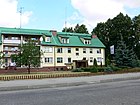Kalisz Pomorski [ˈkalʲiʂ pɔˈmɔrskʲi] (Latin: Nova Calisia; German: Kallies) is a small town in Drawsko County in West Pomeranian Voivodeship in northwestern Poland with about 4,500 inhabitants.
History
In the 8th century a Slavic gród existed in present-day Kalisz Pomorski.[1] In the Middle Ages it was part of Poland, located in northern Greater Poland. The town's name derives from the city of Kalisz in southern Greater Poland.[1] In order to develop this sparsely populated area, duke Przemysł I brought settlers from Kalisz to the settlement, which was newly named in Latin Nova Calisia (meaning New Kalisz).[1]
It was part of the Kingdom of Prussia from the 18th century and between 1871 and 1945 it was part of Germany. During World War II, in 1944–1945, the Germans operated a subcamp of the Ravensbrück concentration camp in the town, in which they imprisoned around 500–1,000 people at a time.[2] After the defeat of Nazi Germany in World War II, the town became part of Poland again.
Gallery
-
Młyńskie Lake
-
Palace in Kalisz Pomorski
-
High school
-
Forest office building
Notable residents
- Paul Sydow (1851 – 1925), German mycologist and lichenologist
International relations
Twin towns — Sister cities
Kalisz Pomorski is twinned with:
References
- ^ a b c "Historia miasta, Miasto i gmina Kalisz Pomorski" (in Polish). Retrieved July 14, 2019.
- ^ Der Ort des Terrors: Geschichte der nationalsozialistischen Konzentrationslager, Vol. IV, 2006, p. 559 (in German)
External links


















